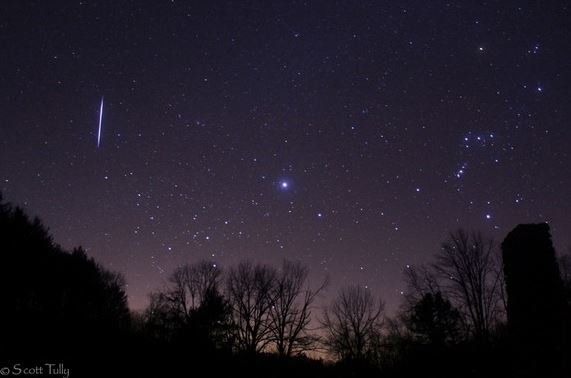Everything you need to know: Camelopardalids
could be the best meteor shower this year
An exciting new meteor shower – the Camelopardalids – might peak this Friday night and Saturday morning (night of May 23-24, 2014), according to clocks in North America. And, although no one can be absolutely sure, mid-latitudes in North America are predicted to have the best view of this shower. It’s coming up soon! This possible shower stems from Comet 209P/LINEAR, discovered in 2004. If the predictions hold true, Earth might be sandblasted with debris from this comet, resulting in a fine display of meteors, or shooting stars on the evening of May 23, and the morning of May 24. Follow the links below to learn more about the possible 2014 meteor shower of Comet 209P/LINEAR.
...
Because of the time predicted for the meteor display, observers in southern Canada and the continental U.S. are especially well positioned to see the meteors in the early morning hours of May 24 (or late at night on May 23). Will the predictions hold true? They are not always 100% reliable, which is why, no matter where you are on Earth, this shower is worth a try around the night of May 23-24.
The meteors will radiate from the constellation Camelopardalis (camelopard), a very obscure northern constellation. Its name is derived from early Rome, where it was thought of as a composite creature, described as having characteristics of both a camel and a leopard. Nowadays we call such a creature a giraffe! Since meteor in annual showers take their names from the constellation from which they appear to radiate – and since this meteor shower might become an annual event – people are already calling it the May Camelopardalids.
This constellation – radiant point of the May 2014 meteor shower – is in the northern sky, close to the north celestial pole, making this meteor shower better for the Northern Hemisphere than the Southern Hemisphere.
...
What we know about Comet 209P/LINEAR. The photo and video above show small and dim Comet 209P/LINEAR. We won’t see this comet with the eye alone. What’s exciting here is that calculations of the orbit of 209P/LINEAR indicate that – on the night of May 23-24, 2014 –
Earth will sweep through debris trails from this comet. Debris left behind by the comet may enter our atmosphere and burn up, creating a new and perhaps very strong meteor shower!
209P/LINEAR is a periodic comet, that is, its orbit around the sun is relatively short so that we see the comet come close to the sun again and again. Comet 209P/LINEAR’s orbit brings it near the sun in just over 5 years. Its last perihelion passage was May 6, 2014. Interestingly, the debris we’ll encounter is not fresh debris left by the comet during its 2014 perihelion passage. Instead, we’ll be passing through a stream of cometary debris left behind by Comet 209P/LINEAR in the 1800s.
This
comet was discovered on February 3, 2004 by the automated observing campaign – the Lincoln Near-Earth Asteroid Research project (LINEAR) – whose name it bears.
...
Will Comet 209P/LINEAR create a meteor storm? In 2012, meteor experts Esko Lyytinen of Finland and Peter Jenniskens at NASA Ames Research Center were the first to announce that Earth was due for a May 2014 encounter with debris from Comet 209P/LINEAR. Other meteor experts quickly confirmed this prediction and some did use the words “meteor storm.” The most recent calculations, however, indicate we might get a strong shower, but perhaps not a storm of meteors.
In 2012, Jeremie Vaubaillon of The Institut de Mecanique Celeste et de Calcul des Ephemerides in France told space.com:
So far,given the observations, we estimate a ZHR (zenithal hourly rate) of 100/hr to 400/hr, which is an excellent outburst! But this shower can become an exceptional one. Indeed, given the current orbit of the comet, all the trails ejected between 1803 and 1924 do fall in the Earth’s path in May 2014! As a consequence, this shower might as well be a storm.
The more recent, less optimistic calculations come from Quanzhi Ye and Paul A. Wiegert, both at University of Western Ontario. Their work was published online in November 2013. In a report on their work at skyandtelescope.com, John Bochanski wrote that Ye and Wiegert’s work
suggests a rate of 200 meteors per hour under ideal conditions. Bochanski wrote:
But Ye and Wiegert warn that, given the current relatively weak dust production of the comet, rates could be much lower. With the low dust production, as well as the team’s lower estimate of how many debris streams from the comet’s previous passes are hanging around in this region of space, it’s highly unlikely that we’re in for a meteor storm (1,000 per hour) — although the team couldn’t quite rule it out.
Will Comet 209P/LINEAR produce a meteor storm, or at least a strong meteor shower? As with all meteor showers, the only way to know is to go outside on the night of the predicted peak and see for yourself.
...
Bottom line: On the night of May 23-24, 2014 –
if predictions hold true – Earth might be sandblasted with debris from Comet 209P/LINEAR, resulting in a fine display of meteors, or shooting stars. The debris stream was laid down by the comet in the 1800s. People are already calling this shower the May Camelopardalids, taking its name from the shower’s radiant point in an obscure far-northern constellation. Will it be a meteor storm? Most recent calculations say no, but it might be a strong-enough shower to be thrilling!





